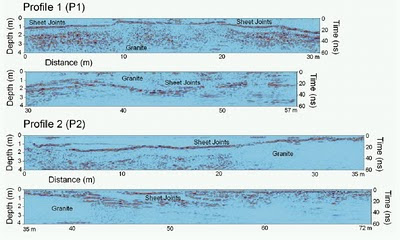Fresh from the press a revelation:
Quartz deposits hold key to predicting earthquakes:
..
The scientists discovered that quartz crystal deposits are found
wherever mountains or fault lines occur in states like California,
Idaho, Nevada and Utah.
The Utah State geoscientist said the
breakthrough came after repeated testing revealed a correlation between
quartz deposits and geologic events that was "completely eye-popping."
Using
newly developed remote sensing technology known as Earthscope, Lowry
and Perez-Gussinye found that quartz indicates a weakness in the earth's
crust likely to spawn a geologic event such as an earthquake or a
volcano.
A friend pointed out to me the above news which came in a
particularly mangled press version of a study published in Nature by Anthony R. Lowry and Marta Pérez-Gussinyé -
The role of crustal quartz in controlling Cordilleran deformation.
In this post-Japan atmosphere of heightened awareness, hype, hyperbole and sensational claims about earthquakes and volcanoes it is important to set the geology straight.
The paper is behind a paywall and I have not read it, but from the abstract I could gather -
The study addresses variations in the presence of
crustal quartz and whether it may influence localization of continental scale deformation due to quartz being weaker than other minerals. The study is on the continental scale and when geologists speak of crustal quartz they mean the mineral that makes up part of the bulk of the rock. Crust with high amounts of quartz would mean crust made up of rocks like granites, granite gneisses and quartz rich schists and quartzites. So variations in the bulk composition of the crust over hundreds of kilometers may influence where deformation occurs and persists over geological time.
Tuzo Wilson imagined the crust being recycled by the repeated opening (rifting) and closing (collisions) of continents, the famous Wilson cycle. This study suggests that such opening of continents may be initiated in quartz rich zones of the crust and these previously rifted and weakened zones are then more likely to break into rifts or deform into mountain belts during subsequent tectonic events thus localizing deformation over many cycles.
The press release though mutates crustal quartz into
crystal quartz deposits accompanied by a picture of an amethyst crystal cluster and announces that such crystal quartz deposits may help us predict earthquakes. Crystal quartz deposits and crustal quartz mean different things to geologists. Crustal quartz as I explained above refers to the mineral quartz that is pervasive throughout the crust making up a proportion of the rock mass along with other minerals.
On the other hand the term crystal quartz deposits usually is taken to mean veins cutting across the rock mass or cavities in the rock which are filled with quartz crystals often as pretty faceted forms. These may occur over very small regions of a few hundred meters to a few kilometers or so and sometimes quartz may occur in concentrations that can be mined.
These types of small segregated deposits of quartz do not automatically indicate an increased likelihood of earthquakes in that particular area. At the most they may point to the presence of a fault. For example fault zones contain fractured rock. Mineralizing fluids containing silica may precipitate quartz concentrations along these fractures. However geologists don't make a leap and announce that an earthquake is likely along that fault anytime in the future based on the presence of these crystal quartz deposits.
Quartz deposits by themselves don't tell us anything about the stress levels the crust is under and whether the fault may slip anytime soon. Independent monitoring of stress levels along faults using sensitive instruments is just beginning to be used in some areas but we are a long way away from using that information to make predictions about an earthquake.
Coming back to the paper...Large continental zones over which the crust has been deformed such as rifts, collision zones or subduction zones are also regions where earthquakes are more likely to occur. We already know that. But while there may be a correlation between crustal quartz amount and such large zones of deformation, that does not translate into specific predictions about where and when earthquakes may occur in these zones. The study certainly does not claim any such advance in our understanding of earthquakes.
I had a thought though about the correlation between quartz rich crustal zones and repeated deformation. Think about the early Archean when continents were forming. What would be the future Indian continent is a collage of several such continental nuclei which welded to each other over the Archean and early Proterozoic. An example is the zone of continental deformation along the Narmada rift in central India which has seen suturing and rifting of continental blocks repeatedly in the Archean and early-mid Proterozoic.
The first location of collision between continental nuclei was not controlled by the presence of quartz but was just happenstance. That initial collision, the zone of suture along which the two continents stuck to each other became the prime zone of weakness in the larger continental block. And during collision that zone likely became richer in quartz as partial melting of the old crust formed differentiated quartz-rich new crust.
This crust because it was weak from a previous collision/deformation event was reactivated during subsequent tectonic events and became even richer in quartz following repeated magmatic and sedimentary differentiation of the crust during each such event.
Is there really a quartz enrichment trend in the Precambrian crust of the Narmada rift? Is quartz rich crust the cause or the consequence of localized crustal deformation? Maybe the relation is different in different settings..maybe there are feedbacks...


